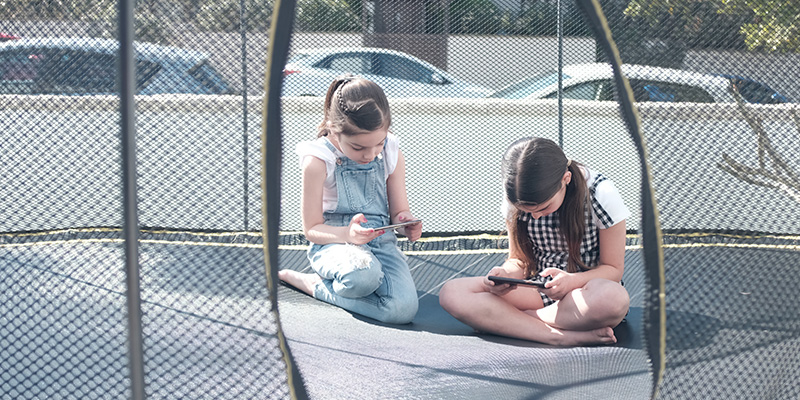The good, the bad, and the downright ugly of our children’s screen time
Are their devices serving up a junk food diet?
It’s 2021. And ‘device’ has become a dirty word.
For many of us parents, it’s symbolic of arguing with children who don’t want to get off their PC, Nintendo, iPad, Xbox or phone. It also triggers our own internal dialogue – that niggling parental guilt about our own indulgences. Because the pandemic has (anecdotally) shown us two clear things:
- More children are using devices for longer periods of time (although they’re using them in more diverse ways than ever before), and
- More of us parents are using devices at home, and in the presence of our children, than ever before.
It’s the eternal battle – we’re questioning our children’s active presence with those around them, while also questioning our own, when we’re distracted by screens.
Our revelation
There are days when we’re just as distracted as they are – whether we’re keeping tabs on the news, scrolling through social media, or watching an episode (or three) of the latest series on Netflix or Stan or Binge or Disney+ or Paramount+ or… you get the picture.
Slowly but surely, devices creep into our day until we no longer notice (or question) their increasing presence. But the process of developing World Wise gave us a completely new perspective. Are they really the all-encompassing enemy we make them out to be?

Apps and games… it’s all about intent
When creating World Wise, our intent was clear. We wanted to create an app that got our children thinking and would add value to them via active participation instead of passive consumption. That was all well and good, but we’re parents creating this for our children. We weren’t going to be the ones playing it.
Our users were school-aged children, ranging from kindergarten to Year 10. And for them to use the app, it had to meet their intent, not ours. Now, there are a stack of educational apps available, but they’re mainly adopted in school settings. But because they’ve been developed to meet the intent of educators, and not children, they’re not something our kids willingly choose for themselves.
Because children want to play.
Let the kids start gaming, we said
To engage the children, we needed to satisfy their wants and needs. At the same time, we needed to remain true to ourselves.
So in creating World Wise, we combined car racing with multiple choice questions. It’s gaming with learning. As they progress, passing checkpoints to upgrade their cars, they become so absorbed in playing that they don’t think twice about our intent behind the multiple-choice questions. And with over 15,000 of them, all aligned to the Australian curriculum and targeted to their specific learning level, they’re unconsciously building skills across English, science, math, geography and general knowledge skills. They’re thinking, planning, and strategising.
Let there be…. screen time?
What this process taught us was that not all screen time is bad.
Channel 9’s reality shows Parental Guidance recently covered the challenges of managing devices in the family. And despite ongoing conversations about levels of screen engagement decreasing the well-being of children, Dr Justin Poulson confirmed that there is little clear-cut evidence. In fact, research has demonstrated that while 5-6 hours a day is problematic (and we view this amount as extreme), it’s more about what type of screen time our children experience rather than how much.
So if all screen time isn’t created equal, what types are better than others?

The Three C’s
We heard the ‘Three C’s’ mentioned, and it really resonated with us – especially after what we’d learned about user intent when designing the World Wise app.
The Three C’s are consumption, connection, and creation.
Consumption (passive): This is primarily where the negative stuff sits. We consume social media, movies, TV… (some series’ are seriously addictive). In this process we’re passive recipients, with little activity or thought required.
Connection (active): Screens can facilitate conversations and enable social connections, while games facilitate virtual dates with friends and family. And some children rely on the refuge of games to connect with people in a positive way, especially those who find making friends in real life a genuine challenge.
Creation (active): These interactions are positive and constructive – think Minecraft, for example. Kids navigate through 3D virtual worlds, imagining and constructing all manner of items. They’re creating, actively thinking about distance and space, developing their visual-spatial skills.
(Visual-spatial trouble can make learning to read and do math harder – think about the numbers ‘6’ and ‘9’ or the letters ‘W’ and ‘M’, for example. Each has different meanings depending on their rotation on the page.)
Using the Three C’s to guide our decisions as parents
If active screen time can be positive, it stands to reason that all screen time isn’t created equal.
At World Wise, we see active screen time as part of our everyday diet, while passive screen time is the equivalent of junk food – an indulgence that’s enjoyed sparingly.
It’s the ‘treats’ analogy – while we all love ourselves a treat, we know that too much junk food is bad for us. So just as we limit how much junk food we consume, we need to limit how much passive screen time we (and our kids) consume.
We’ll be the first to advocate for relaxing and escapism, and passive screen time definitely has its place. But given that not all screen time is created equal, it’s about balance and being intentional with our usage.
So instead of seeing all screen time as negative, perhaps we need to reframe the conversation and focus on the quality of their engagement, as opposed to quantity alone.

Becoming intentional with how we use our devices
We’re not saying excessive hours on screen time is OK. But we do believe that recognising the different types of screen time, and acknowledging that not all time is created equal, is fundamental to managing our children’s engagement with devices.
As parents, we’re so caught up feeling guilty if our children spend an arbitrary number of hours in front of a screen. And it was only by developing World Wise that we learned:
- The difference between reward, competition, and genuine escapism (passive consumption) against engagement, creativity, and connection (active consumption), and
- The difference in value that each brings to the table.
Which makes us ask, shouldn’t we be focusing the screen time discussion around quality and quantity, not just quantity?
It’s food for thought.
Want to talk about how to have that conversation?
If you agree and want to talk it through with the family, we’re with you! Knowing where and how to start getting everyone on the same page (positively) can be tough, so we’re documenting our ideas about how to approach this as we speak. In the meantime, please share your thoughts and experiences – we really want to know!
PS If you’re keen to join us in a closed Facebook group to talk all things parenting in the digital era, let us know below!
Author bio
We’re Julie Samus and Tanya Alexander, co-founders and creators of the World Wise App. With 8 children between us, we’ve lived the mayhem of juggling multiple extra-curricular activities. We’ve also felt the guilt as waiting siblings became passive users of technology to pass the time.
So we created World Wise, transforming that passive consumption into active engagement.
And while progressive learning makes it suitable for kindergarten to (roughly) Year 9 students, the gaming platform means big kids love it, too.
It’s a game changer – literally.


Thanks for your blog, nice to read. Do not stop.
Thank you for the positive feedback.